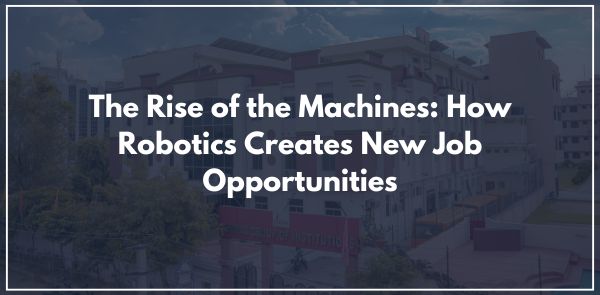
The narrative around robotics and automation has often been one of fear and uncertainty, with concerns about machines taking over human jobs dominating discussions. However, a closer look reveals a more nuanced picture. While automation and robotics indeed transform the job market, they also create a plethora of new opportunities, reshaping industries and driving economic growth. Poddar International College is the Best MCA College in Jaipur.
Robotics has come a long way from its early days of simple, repetitive machines. Today, advanced robotics and artificial intelligence (AI) enable machines to perform complex tasks, learn from their environments, and even interact with humans in natural ways. This evolution is evident across various sectors, including manufacturing, healthcare, logistics, and service industries.
1. Engineering and Development:
The design, development, and maintenance of robots require a highly skilled workforce. This need has spurred demand for robotics engineers, software developers, AI specialists, and technicians. Universities and technical institutions are rapidly expanding their programs to train students in these cutting-edge fields, preparing them for high-paying, challenging careers in robotics and automation.
2. New Roles in Manufacturing:
While robots have taken over some repetitive tasks on the factory floor, they have also created new roles that require human oversight. Jobs in robot maintenance, programming, and supervision are now essential. Additionally, with robots handling more hazardous tasks, the workplace has become safer, leading to better working conditions and new roles focused on ensuring the seamless integration of robots and human workers.
3. Healthcare Innovations:
Robotics in healthcare is revolutionizing patient care and medical procedures. Surgical robots assist doctors in performing precise operations, reducing recovery times and improving outcomes. This technology has created jobs for robotic surgery specialists, biomedical engineers, and technicians who develop and maintain these sophisticated machines. Furthermore, assistive robots in elder care and rehabilitation open new avenues for healthcare professionals trained to work alongside these technologies.
4. Logistics and Supply Chain Management:
Automation in logistics and supply chain management has led to the emergence of smart warehouses where robots handle sorting, packing, and transporting goods. This shift has created new jobs in robot maintenance, systems management, and logistics planning. Professionals skilled in managing automated systems are in high demand, ensuring the smooth operation of these advanced facilities.
5. Service Industry Transformation:
Robots are increasingly entering the service industry, performing tasks ranging from customer service to food preparation. This trend is leading to new roles in robot design, user experience (UX) development, and service management. For instance, robotic baristas and hotel service robots require teams to manage their deployment, ensure their functionality, and enhance their interaction with customers.
As robotics technology evolves, the importance of upskilling and continuous learning becomes paramount. Governments, educational institutions, and corporations are investing heavily in training programs to equip the workforce with the necessary skills to thrive in a robotics-driven economy. Online courses, certifications, and specialized degree programs in robotics and AI are becoming increasingly popular, providing accessible pathways for career advancement.
Robotics is also influencing the gig economy by enabling new types of freelance and contract work. For example, drone operators, remote robotic operators, and freelance AI trainers are emerging roles that offer flexible job opportunities. This shift allows workers to engage with cutting-edge technology without being tied to traditional employment models.
While the rise of robotics offers numerous opportunities, it also presents challenges that need to be addressed. Workforce displacement and the skills gap are significant concerns. Governments and industries must collaborate to create robust support systems, including retraining programs and social safety nets, to ensure a smooth transition for displaced workers. Additionally, ethical considerations regarding AI and robotics must be carefully managed to ensure the technology is used responsibly and for the greater good.
The rise of the machines, far from heralding an era of mass unemployment, is creating new job opportunities and transforming industries in ways previously unimaginable. By embracing this technological revolution and investing in education and training, we can harness the potential of robotics to drive economic growth, improve working conditions, and create a more dynamic and innovative job market. As we navigate this transition, it is essential to foster a collaborative approach that balances technological advancement with social and ethical responsibility, ensuring a future where humans and machines work together harmoniously. Poddar International College is a Leading Institute Offering Web Application Courses.